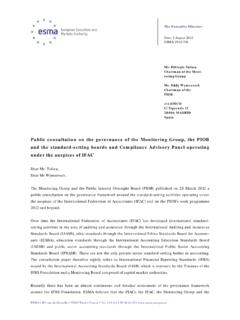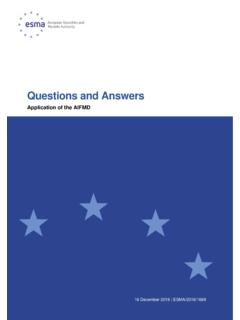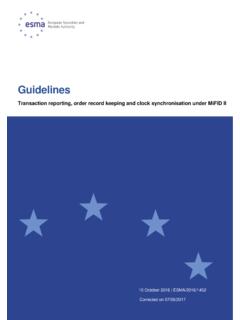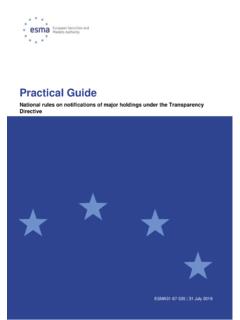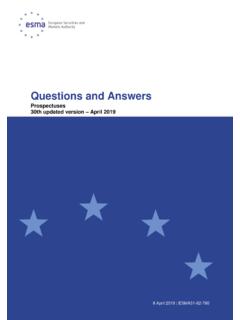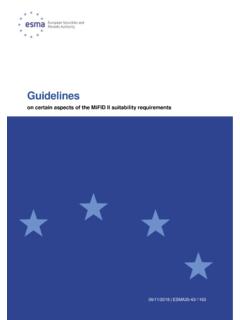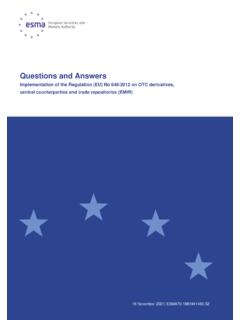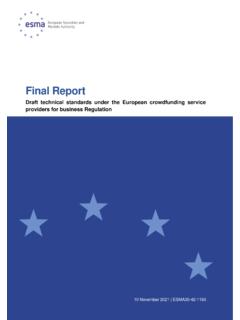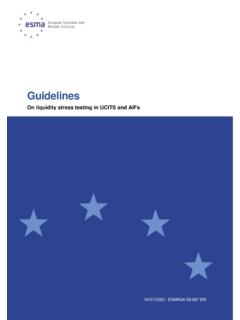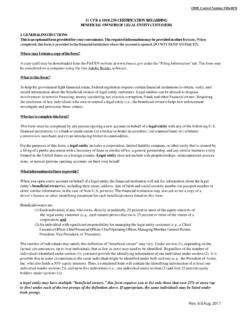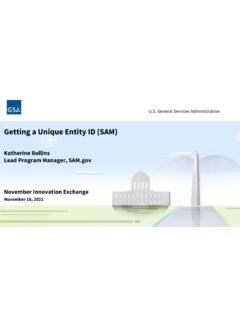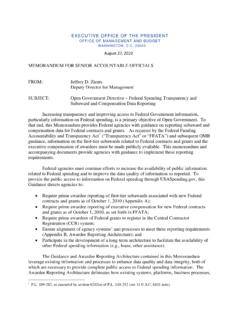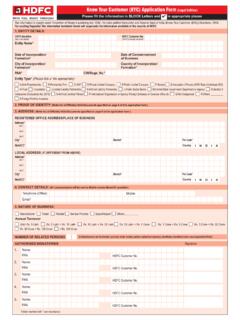Transcription of BRIEFING Legal Entity Identifier (LEI) - Europa
1 ESMA CS 60747 103 rue de Grenelle 75345 Paris Cedex 07 France Tel. +33 (0) 1 58 36 43 21 BRIEFING Legal Entity Identifier (LEI) The Legal Entity Identifier (LEI) is a 20-digit, alpha-numeric code that enables clear and unique identification of Legal entities participating in financial LEIs, like other identifiers , are needed by firms to fulfil their reporting obligations under financial regulations and directives. LEIs are also key for matching and aggregating market data, both for transparency and regulatory purposes. The code is linked to a set of key reference information relating to the Legal Entity in question name and address2.
2 Once a Legal Entity obtains a LEI code, the code is assigned to that Legal Entity for its entire life. Who needs it The use of an LEI is already required under a number of EU regulations and directives such as: European Markets Infrastructure Regulation (EMIR) counterparties to derivatives contracts as well as beneficiaries, brokers, CCPs and clearing members3; Market Abuse Regulation (MAR) issuers of financial instruments; entities involved or reporting in suspicious transactions4; Capital Requirements Regulation (CRR) credit and financial institutions5; Alternative Investment Funds Directive (AIFMD) funds and fund managers6.
3 Credit Rating Agencies Regulation (CRAR) credit rating agencies and rated entities7; Solvency II pension funds and insurance companies8; Central Securities Depositories Regulation (CSDR) CSDs, CSDs participants9; Transparency Directive issuers of financial instruments listed on Regulated Markets10; Securities Financing Transactions Regulation (SFTR) parties involved in securities financing transactions and the beneficiaries of the rights and obligations arising from 1 Question and Answers-About LEI- What is a Legal Entity Identifier (LEI)?
4 2 The complete list is available here: 3 EMIR technical standards on reporting are available on ESMA website. 4 The relevant MAR technical standards are: 1) Reporting suspicious transactions and orders and 2) Managers transactions. 5 For further details, see the EBA recommendation;. 6 The relevant rules are available on ESMA website 7 The relevant technical standards are available at this link. 8 The relevant rules are the following: Directive 2009/138/EC and EIOPA Guidelines; 9 The relevant rules are CSDR technical standards at this link and the CSD Q&As 3(b) and (f) available on ESMA website.
5 10 The relevant technical standards are available at this link. 09 October 2017 ESMA70-145-238 2 these11; Prospectus Regulation issuers of securities offered to the public or admitted to trading on a regulated market situated or operating within a EU member state12; and Markets in Financial Instruments Directive II (MiFID II)/Markets in Financial Instruments Regulation (MiFIR) see dedicated section below. In addition, the use of the LEI is required or are in the process of being implemented by other regulators, including those in the US, Canada and Asia-Pacific13. Who can apply for it Any Legal Entity can apply for an LEI.
6 The term Legal Entity includes, but is not limited to, unique parties that are legally or financially responsible for the performance of financial transactions, or have the Legal right in their jurisdiction to enter independently into Legal contracts, regardless of whether they are incorporated or constituted in some other way trust, partnership, contractual. It excludes natural persons, but includes individuals acting in a business capacity14. It also includes governmental organisations and supranationals15. Why is it important The LEI provides a unique Identifier for all entities participating in financial transactions that can also be used on a cross border basis, through a free and open database updated on a daily basis.
7 This common framework is crucial to identifying clearly each exposure for risk management of financial transactions, to create transparency, and conduct market surveillance. The use of the LEI also generates tangible benefits for businesses including simplified regulatory reporting; database management free of charges; more accurate calculation of counterparty exposures; improved risk management; and increased operational efficiencies. In this context, the LEI will provide benefits in terms of costs and new business opportunities, as a reliable, open, standardised, and high quality Legal Entity reference data shared across the market place16.
8 How to obtain the LEI Obtaining an LEI is straightforward. An interested Entity should contact the preferred LEI issuing organisation (LEI issuer, also known as Local Operating Unit). The list of LEI issuers 11 The relevant technical standards are available at this link. 12 13 Overview of all regulatory requirements concerning the LEI is available on the LEI Regulatory Oversight Committee website. 14 15 General information about ISO 17442: 16 Our Vision: One Identity Behind Every Business 3 is available on the Global LEI Foundation (GLEIF) website.
9 The LEI data is registered and regularly verified according to protocols and procedures established by the LEI Regulatory Oversight Committee (LEI ROC), a group of public authorities from around the globe established in January 2013 to coordinate and oversee the framework of Legal Entity identification. GLEIF acts as the operational arm of the LEI ROC, making available, free of charge, the only global online source that provides the Legal Entity reference data17. A search function is available where users can check if an Entity has an LEI, or access the reference data associated with an LEI18.
10 It should be noted that a Legal Entity is not obliged to use an LEI issuer from its own country. Legal entities are free to choose their preferred LEI issuer based on their own specific needs and costs considerations. The costs of an LEI vary depending on the LEI issuer; however, each LEI issuer is obliged to operate on a cost recovery basis; the fee charged by the LEI issuer is also limited by competition with all other LEI issuers. Furthermore, to streamline the issuance of LEIs, the GLEIF has introduced the concept of the Registration Agent. A Registration Agent helps Legal entities to access the network of LEI issuing organisations responsible for performing LEI issuance and related services.
